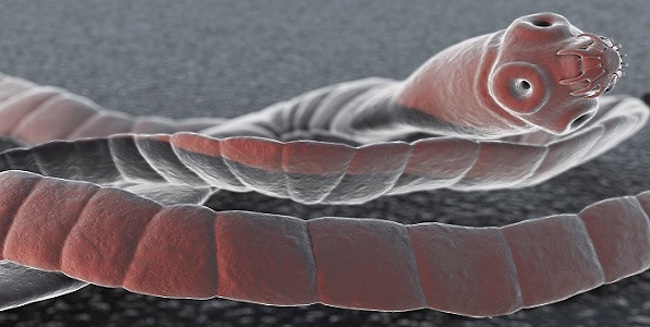
Scientists from the CDC have discovered a worrying new cancer-like condition in a 41-year-old man who is believed to have contracted the disease via tapeworms.
This is the world’s first cast of cancer transmission from a parasite to a human, and involved an HIV patient from Colombia who developed multiple large tumors all over his body. He died 72 hours after being diagnosed.

BYPASS THE CENSORS
Sign up to get unfiltered news delivered straight to your inbox.
You can unsubscribe any time. By subscribing you agree to our Terms of Use
Latest Video
Washingtonpost.com reports:
Local doctors biopsied those tumors and found that the cells acted like cancer cells in their destructiveness but were strange in other respects. For one, they were about 10 times smaller than normal human cancer cells. The doctors contacted the CDC for help.
Atis Muehlenbachs, an agency pathologist in the special unit that investigates unexplained mystery illnesses and deaths, wasn’t sure what to make of the cell samples when he and his team received them in 2013. The cells’ growth pattern was cancer-like, they noticed, with overcrowding and a high rate of multiplication. But the cells also fused together, which is rare for human cells.
One early theory, Muehlenbachs said in an interview Wednesday, was that they could be a new type of infectious organism. But after performing dozens of tests, the team discovered the cells contained DNA snippets of a dwarf tapeworm, Hymenolepis nana. That analysis was verified by a researcher and tapeworm expert at the Natural History Museum in London.
“In the initial months, we wondered if this was a weird human cancer or some unusual, bizarre emerging protozoa-amoeba-like infection,” he recalled. “Discovering these cells had tapeworm DNA was a big surprise — a really big surprise.”
The CDC researchers, who published their findings Wednesday in the New England Journal of Medicine, now think the Colombian man may have ingested some microscopic tapeworm eggs, most likely in food contaminated by mouse droppings, insects or human feces. Because of the man’s compromised immune system, the tapeworms multiplied rapidly inside his gastrointestinal tract and the cells invaded other parts of his body. It’s unclear whether the cells in the tapeworm eggs exhibited cancer-like properties before they entered the man’s body or whether some interaction between the parasite and his body then caused them to become cancerous.
“This is the first time we’ve seen parasite-derived cancer cells spreading within an individual,” Muehlenbachs said. “This is a very unusual, very unique illness.”
The case study is worrisome for numerous reasons.
We know that many creatures, such as various sea animals, are susceptible to cancer, while others, like elephants, are almost immune to it. But until now, scientists had not believed that any human parasite could harbor cancer cells or transfer them to people.
We’ve also known that certain parasitic infections may put people at higher risk for specific cancers — such as flatworms for bile duct cancer or a river creature called schistosoma haematobium for bladder cancer, according to the American Cancer Society. But the reason was wholly different, namely a hyper-immune response that may weaken an individual.
The presence of cancerous cells in tapeworms also raises numerous questions about where the mutant cells originated — from something in the environment? — and whether other organisms that live inside or on people that could transmit cancer cells. In recent years, many scientists have emphasized that the human body’s ecosystem is only made up of 10 percent human cells but 90 percent microbial cells.
“We didn’t believe that cells from a human parasite could become malignant and then invade human tissue. … It’s just very unusual that the parasite’s cells became cancerous inside a human and then invaded into human tissue,” Bobbi Pritt, director of clinical parasitology at the Mayo Clinic, said in an interview.
Yet the idea of tapeworms also being vulnerable to cancer makes some sense, Pritt said, as “every living animal is made up of cells that divide and could become cancerous.”
Cancer is generally not considered to be a transmittable disease, although there have been very rare cases of humans passing on malignant cells to other humans through organ transplants or from mother to fetus during pregnancy. There are also some animal species — such as Tasmanian devils and domestic dogs — that are known to have transmissible cancer cells circulating within their populations. The CDC does not believe there is any risk of the tapeworm cancer cells being spread directly from one person to another.
It’s unclear how common this type of tapeworm cancer illness is in humans, but experts like Pritt believe it’s likely that there are more cases out there: “H. nana is a very common tapeworm infection in humans, and therefore I would expect there to be other cases like the one described…that were misdiagnosed or went undetected.”
…
By the time the CDC researchers figured out what was going on, the man’s condition had deteriorated and he was in hospice care. He died 72 hours later, without any opportunity for treatment. His official cause of death was HIV/AIDS, with cancer a contributor to his weakened state.


